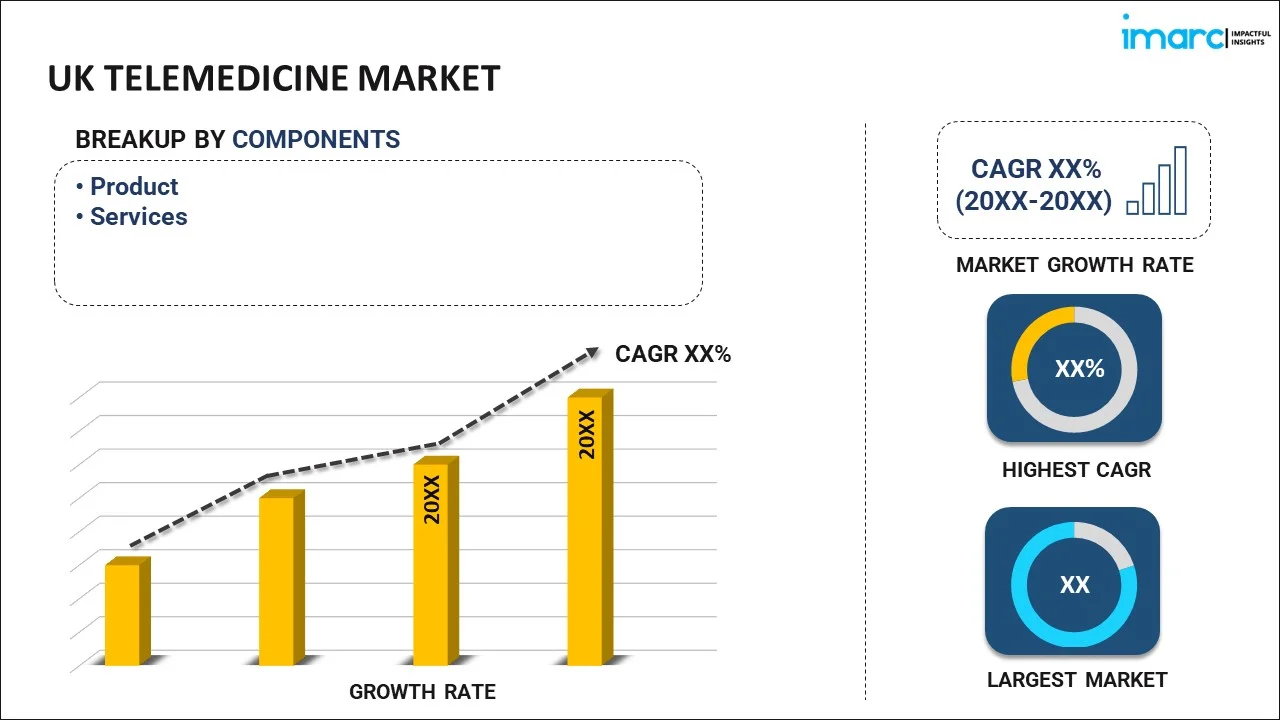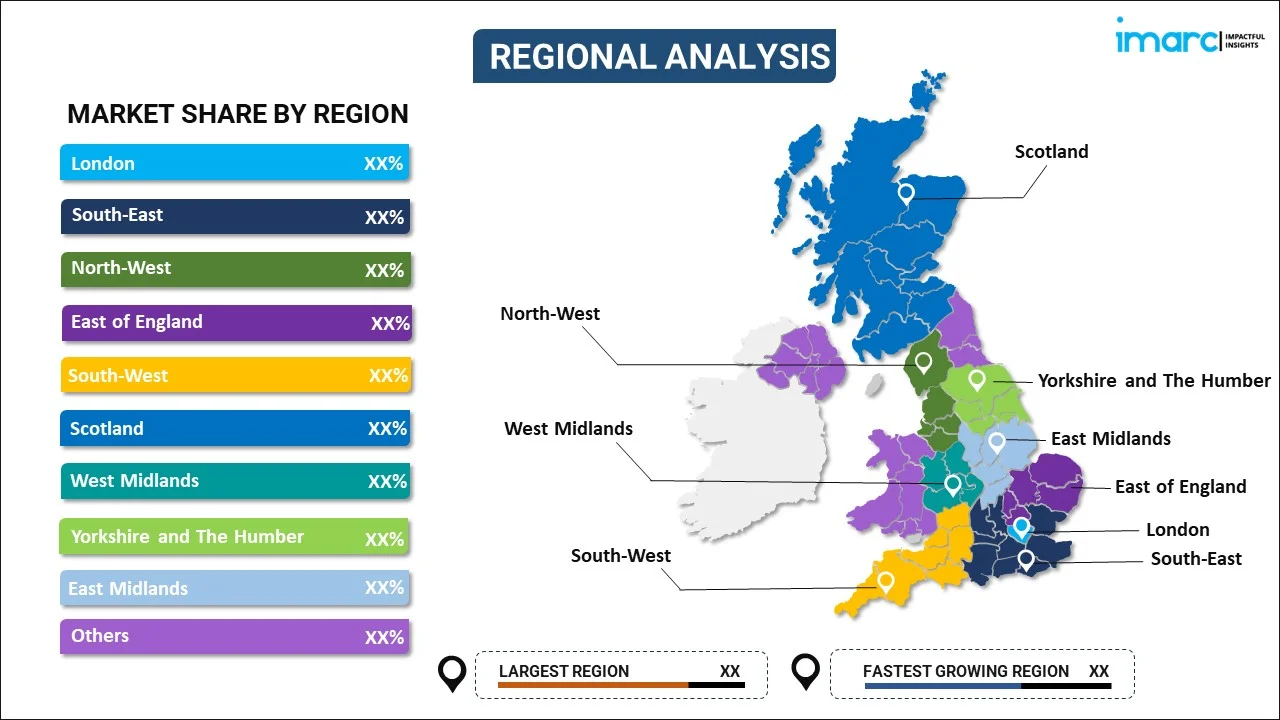
UK Telemedicine Market Report by Component (Product, Services), Modality (Real-Time, Store and Forward, and Others), Delivery Mode (Web/Mobile, Call Centers), Facility (Tele-Hospital, Tele-Home), Application (Teledermatology, Teleradiology, Telepsychiatry, Telepathology, Telecardiology, and Others), End user (Providers, Payers, Patients), and Region 2025-2033
UK Telemedicine Market Overview:
The UK telemedicine market size reached USD 3,018.6 Million in 2024. Looking forward, IMARC Group expects the market to reach USD 10,599.3 Million by 2033, exhibiting a growth rate (CAGR) of 14.98% during 2025-2033. Increased demand for remote healthcare solutions amid COVID-19, advancements in technology enhancing service efficacy, governmental support through funding and regulatory reforms, rising chronic disease prevalence, demographic trends like an aging population, and regulatory reforms facilitating telehealth reimbursement are some of the factors boosting the market growth.
|
Report Attribute
|
Key Statistics
|
|---|---|
|
Base Year
|
2024
|
|
Forecast Years
|
2025-2033
|
|
Historical Years
|
2019-2024
|
| Market Size in 2024 | USD 3,018.6 Million |
| Market Forecast in 2033 | USD 10,599.3 Million |
| Market Growth Rate 2025-2033 | 14.98% |
UK Telemedicine Market Trends:
Increasing Demand for Remote Healthcare Solutions
The COVID-19 pandemic has significantly increased demand for out-of-hospital healthcare solutions in the UK, which is further boosting the telemedicine market in the country. Telemedicine offers medical facilities to patients who want convenient access to medical consultations. This trend has not only been driven by necessity during health crises but also by the ongoing preference for flexible healthcare options among consumers. Moreover, the ready availability of expert personnel enables timely delivery, which is a key driver especially for regular inspections, follow-up visits, and the remote management of chronic diseases.
Advancements in Technology and Digital Health Platforms
Advances in telecommunication technologies and digital health platforms have reshaped the UK telemedicine market. Recent technological innovations have greatly enhanced the effectiveness and access of telemedical services have been heavily improved. The rapid penetration of the internet connections has made it easy to have virtual consultations between health care providers and patients. Additionally, with records systems that can be automatically interconnected on an electronic basis from each stage of management, the need to physically visit a medical facility has reduced significantly. Telemedicine allows immediate communication and provides support for remote monitoring of patient vital signs and health data at any time.
Governmental Support and Initiatives
The UK government has played a pivotal role in driving the adoption of telemedicine through supportive initiatives and investments in digital health infrastructure. Recognizing the potential of telehealth to improve healthcare accessibility and efficiency, policymakers have introduced various incentives and funding programs to integrate telemedicine into national healthcare systems. These initiatives include grants for healthcare organizations to implement telehealth solutions, reimbursement reforms to facilitate telemedicine consultations, and regulatory frameworks to ensure patient safety and quality of care. Governmental support has provided a conducive environment for healthcare providers to embrace telemedicine as a viable alternative to traditional in-person care, particularly in rural and underserved areas where access to healthcare services is limited.
UK Telemedicine Market News:
- In 2023, Babylon Health sold certain assets to eMed Healthcare UK Ltd., a new subsidiary of a US-based company. The sale excluded Babylon's popular GP at Hand app, which continues to operate, ensuring minimal disruption to existing users. These measures were taken after Babylon struggled financially, ending its partnerships with University Hospitals Birmingham Foundation Trust and The Royal Wolverhampton Trust due to economic non-viability.
- In 2023, Ubie, a cutting-edge AI symptom checker with over 7 million users each month, has partnered with HealthTap, a prominent virtual healthcare provider in the US. This collaboration will allow Ubie's American users to connect with board-certified HealthTap doctors in real-time directly through the Ubie platform.
UK Telemedicine Market Segmentation:
IMARC Group provides an analysis of the key trends in each segment of the market, along with forecasts at the country level for 2025-2033. Our report has categorized the market based on component, modality, delivery mode, facility, application, and end user.
Component Insights:

- Product
- Hardware
- Software
- Others
- Services
- Tele-Consulting
- Tele-Monitoring
- Tele-Education
The report has provided a detailed breakup and analysis of the market based on the component. This includes product (hardware, software, and others) and services (tele-consulting, tele-monitoring, and tele-education).
Modality Insights:
- Real-Time
- Store and Forward
- Others
A detailed breakup and analysis of the market based on the modality have also been provided in the report. This includes real-time, store and forward, and others.
Delivery Mode Insights:
- Web/Mobile
- Audio/Text-based
- Visualized
- Call Centers
The report has provided a detailed breakup and analysis of the market based on the delivery mode. This includes web/mobile (audio/text-based and visualized) and call centers.
Facility Insights:
- Tele-Hospital
- Tele-Home
A detailed breakup and analysis of the market based on the facility have also been provided in the report. This includes tele-hospital and tele-home.
Application Insights:
- Teledermatology
- Teleradiology
- Telepsychiatry
- Telepathology
- Telecardiology
- Others
The report has provided a detailed breakup and analysis of the market based on the application. This includes teledermatology, teleradiology, telepsychiatry, telepathology, telecardiology, and others.
End user Insights:
- Providers
- Payers
- Patients
A detailed breakup and analysis of the market based on the end user have also been provided in the report. This includes providers, payers and patients.
Regional Insights:

- London
- South East
- North West
- East of England
- South West
- Scotland
- West Midlands
- Yorkshire and The Humber
- East Midlands
- Others
The report has also provided a comprehensive analysis of all the major regional markets, which include London, South East, North West, East of England, South West, Scotland, West Midlands, Yorkshire and The Humber, East Midlands, and Others.
Competitive Landscape:
The market research report has also provided a comprehensive analysis of the competitive landscape. Competitive analysis such as market structure, key player positioning, top winning strategies, competitive dashboard, and company evaluation quadrant has been covered in the report. Also, detailed profiles of all major companies have been provided.
UK Telemedicine Market Report Coverage:
| Report Features | Details |
|---|---|
| Base Year of the Analysis | 2024 |
| Historical Period | 2019-2024 |
| Forecast Period | 2025-2033 |
| Units | Million USD |
| Scope of the Report | Exploration of Historical Trends and Market Outlook, Industry Catalysts and Challenges, Segment-Wise Historical and Future Market Assessment:
|
| Components Covered |
|
| Modalities Covered | Real-Time, Store and Forward, Others |
| Delivery Modes Covered |
|
| Facilities Covered | Tele-Hospital, Tele-Home |
| Applications Covered | Teledermatology, Teleradiology, Telepsychiatry, Telepathology, Telecardiology, Others |
| End Users Covered | Providers, Payers, Patients |
| Regions Covered | London, South East, North West, East of England, South West, Scotland, West Midlands, Yorkshire and The Humber, East Midlands, Others |
| Customization Scope | 10% Free Customization |
| Post-Sale Analyst Support | 10-12 Weeks |
| Delivery Format | PDF and Excel through Email (We can also provide the editable version of the report in PPT/Word format on special request) |
Key Questions Answered in This Report:
- How has the UK telemedicine market performed so far and how will it perform in the coming years?
- What has been the impact of COVID-19 on the UK telemedicine market?
- What is the breakup of the UK telemedicine market on the basis of component?
- What is the breakup of the UK telemedicine market on the basis of modality?
- What is the breakup of the UK telemedicine market on the basis of delivery mode?
- What is the breakup of the UK telemedicine market on the basis of facility?
- What is the breakup of the UK telemedicine market on the basis of application?
- What is the breakup of the UK telemedicine market on the basis of end user?
- What are the various stages in the value chain of the UK telemedicine market?
- What are the key driving factors and challenges in the UK telemedicine?
- What is the structure of the UK telemedicine market and who are the key players?
- What is the degree of competition in the UK telemedicine market?
Key Benefits for Stakeholders:
- IMARC’s industry report offers a comprehensive quantitative analysis of various market segments, historical and current market trends, market forecasts, and dynamics of the UK telemedicine market from 2019-2033.
- The research report provides the latest information on the market drivers, challenges, and opportunities in the UK telemedicine market.
- Porter's five forces analysis assist stakeholders in assessing the impact of new entrants, competitive rivalry, supplier power, buyer power, and the threat of substitution. It helps stakeholders to analyze the level of competition within the UK telemedicine industry and its attractiveness.
- Competitive landscape allows stakeholders to understand their competitive environment and provides an insight into the current positions of key players in the market.
Need more help?
- Speak to our experienced analysts for insights on the current market scenarios.
- Include additional segments and countries to customize the report as per your requirement.
- Gain an unparalleled competitive advantage in your domain by understanding how to utilize the report and positively impacting your operations and revenue.
- For further assistance, please connect with our analysts.

 Inquire Before Buying
Inquire Before Buying
 Speak to an Analyst
Speak to an Analyst
 Request Brochure
Request Brochure
 Request Customization
Request Customization



.webp)




.webp)












